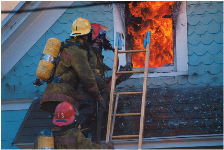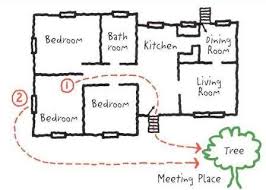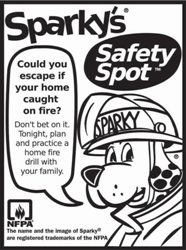
Although deaths and injuries from residential fires have decreased in the past several years, deaths from fires and burns are still the third leading cause of fatal home injuries according to the Center for Disease Control and Prevention (CDC) Seventy percent of these deaths are from inhaling smoke. Two-thirds of deaths from home fires occurred in homes with no smoke alarms or no working smoke alarms.
Safety Tips
Become familiar with the basic fire safety tips and then read further for a more in depth look into home fire safety.
- Complete a home fire safety checklist and identify fire risks in your home.
- Test smoke alarms and carbon monoxide detectors monthly and change the batteries at least once a year.
- Place smoke alarms on each floor of your home and in each bedroom.
- Make sure that everyone in the home can hear the smoke alarm from their bedrooms.
- Make a family fire escape plan and practice it once a month.
- Make sure that everyone in the house understands the family fire escape plan.
- Place fire extinguishers throughout your home and make sure everyone in the house knows how to use them.
- Never leave food unattended on the stove (Cooking and Grilling Safety Tips), keep all matches and lighters out of the reach of children, and don’t place portable heaters near flammable materials.
The most effective way to protect yourself and your home from fire is to identify and remove fire hazards.
Fire Inspection Checklist
- Electrical cords are in good condition and not damaged.
- Appliances and lights are plugged into separate electrical outlets.
- All smoke alarms work when tested.
- All escape routes are clear of clutter and easily accessible.
- Curtains and other things that can burn are way from stove-top.
- Portable space heaters are 3 feet away from anything that can burn.
- Portable space heaters are off whenever you leave the room or go to sleep.
- Clothes dryer has a clean vent and filter, no build up.
- Whenever food is cooking, stay in the kitchen
- Extension cords are used safely, not under rugs or across walking areas.
- The furnace and chimney has been inspected and cleaned each year.
- Take the Home Fire Safety Survey offered by the National Fire Protection Agency.

You can also protect your family and yourself from fire by:
Fire Extinguishers
The use of fire extinguisher in the hands of a train adult can be a life property saving tool. However, a majority of adults have not had fire extinguisher training and may not know how and when to use them. Fire extinguisher use requires a sound decision making process and training on their proper use and maintenance.
- Learn about the different types and how to use a fire extinguisher. It is vital to know what type of extinguisher you are using and how to use it. Using the wrong type for the wrong type of fire can be life-threatening.
- Choose a fire extinguisher that carries the label of an independent testing laboratory.
- Use a portable fire extinguisher when the fire is confined to a small area, such as a wastebasket, and is not growing; everyone has exited the building; the fire department has been called or is being called; and the room is not filled with smoke.
- Keep your fire extinguisher in an easily accessible place.
- Fire extinguishers have gauges on them indicating when they need to be replaced. They should be check regularly to make sure they are still functional.
- Know when to go. Fire extinguishers are one element of a fire response plan, but the primary element is safe escape. Every household should have a home fire escape plan and working smoke alarms.
Smoke Alarms
Working smoke alarms and a fire explain plan that has been practiced regularly can save lives.
- Install smoke alarms on every level of your home, inside bedrooms and outside sleeping areas.
- If possible, replace smoke alarms with interconnected alarms. When one alarm goes off, the other will sound too.
- Change the battery to your smoke alarm once a year and change the whole unit every 10 years.
- Test your smoke alarm monthly
- Make sure your kids are familiar with the sound of the alarm.
- For more information view our Smoke Alarm Safety page.
Family Escape Route

- Make sure everyone in your family knows at least two ways to escape from every room of your home.
- Practice fire escape plan at least twice a year. Designate a meeting spot outside and a safe distance from your home.
- Have your family practice escaping from your home, practicing low crawling and at different times of the day.
- Make sure everyone knows how to call 9-1-1.
- Once you get out of your home, stay out!
Know What to do in Case of a Fire
- Never open a door that feels hot, escape another way.
- Take the safest route, but if you have to go through smoke, crawl low and under the smoke. Cover your nose and mouth with a moist towel (if possible) or an article of clothing.
- If smoke, heat,. or flames block your exit routes, stay in the room with the door closed. If possible, place a towel under the door and call 9-1-1 and alert them of your location in the home. Go to the window and signal for help waving a bright-colored cloth or a flashlight. Do not break the window, but open it form the top and bottom.
- Teach your family to stop, drop to the ground, and roll if their clothes catch on fire. Practice this with your family.
- Once you get out of the home, stay out under all circumstance, until fire officials give you permission to go back inside.

Safety Tips for Kids
Smoke alarm and home fire escape planning
- If there is a fire in your home, there will be smoke
- A smoke alarm will let you know there is a fire.
- A smoke alarm makes a loud noise – beep, beep, beep
- When the smoke alarm sounds, get outside and stay outside.
- Go to your family outside meeting place.
When you go home today, be a smoke alarm detective
- Ask a grown-up to show you where the smoke alarms are in your home.
- Ask a grown-up to test the smoke alarms to make sure they are working.
Be a home fire escape planner
- Make a map of your home. Mark a door and a window that can be used to get out of every room. (Download the Home Fire Escape Plan (PDF, 632 KB) provided by National Fire Protection Association.)
- Choose a meeting place outside in front of your home. This is where everyone can meet once they’ve escaped. Draw a picture of your outside meeting place on your escape plan.
- Write the emergency telephone number for the fire department on your escape plan.
- Have a grown-up sound the smoke alarm and practice your escape plan with everyone living in your home.
- Keep your escape plan on the refrigerator and remind grown-ups to have your family practice the plan twice a year or whenever anyone in your home celebrates a birthday.
*Sources: American Red Cross (www.redcross.org), National Safety Council (www.nsc.org), and National Fire Protection Agency (www.nfpa.org)*
